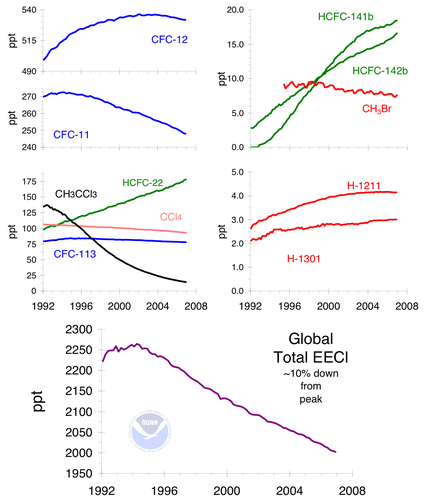Montreal Protocol
January 1, 1989
2. In 1973 Chemists Frank Sherwood Rowland and Mario Molina, then at the University of California, Irvine, began studying the impacts of CFCs in the Earth's atmosphere. They discovered that CFC molecules were stable enough to remain in the atmosphere until they got up into the middle of the stratosphere where they would finally (after an average of 50–100 years for two common CFCs) be broken down by ultraviolet radiation releasing a chlorine atom. Rowland and Molina then proposed that these chlorine atoms might be expected to cause the breakdown of large amounts of ozone (O3) in the stratosphere.
3. The environmental consequence of this discovery was that, since stratospheric ozone absorbs most of the ultraviolet-B (UV-B) radiation reaching the surface of the planet, depletion of the ozone layer by CFCs would lead to an in increase in UV-B radiation at the surface, resulting in an increase in skin cancer and other impacts such as damage to crops and to marine phytoplankton. But the Rowland-Molina hypothesis was strongly disputed by representatives of the aerosol and halocarbon industries. The chair of the board of DuPont was quoted as saying that ozone depletion theory is "a science fiction tale...a load of rubbish...utter nonsense". Robert Abplanalp, the president of Precision Valve Corporation (and inventor of the first practical aerosol spray can valve), wrote to the Chancellor of UC Irvine to complain about Rowland's public statements
4. The Montreal protocol is designed to protect the ozone layer by phasing out the production of a number of substances believed to be responsible for ozone depletion.
5. Since the Montreal Protocol came into effect, the atmospheric concentrations of the most important chlorofluorocarbons and related chlorinated hydrocarbons have either leveled off or decreased. Halon concentrations have continued to increase, as the halons presently stored in fire extinguishers are released, but their rate of increase has slowed and their abundances are expected to begin to decline by about 2020. Also, the concentration of the HCFCs increased drastically at least partly because for many uses CFCs (e.g. used as solvents or refrigerating agents) were substituted with HCFCs. While there have been reports of attempts by individuals to circumvent the ban, e.g. by smuggling CFCs from undeveloped to developed nations, the overall level of compliance has been high. In consequence, the Montreal Protocol has often been called the most successful international environmental agreement to date. In a 2001 report, NASA found the ozone thinning over Antarctica had remained the same thickness for the previous three years, however in 2003 the ozone hole grew to its second largest size. The most recent (2006) scientific evaluation of the effects of the Montreal Protocol states, "The Montreal Protocol is working: There is clear evidence of a decrease in the atmospheric burden of ozone-depleting substances and some early signs of stratospheric ozone recovery."
Unfortunately, the hydrochlorofluorocarbons, or HCFCs, and hydrofluorocarbons, or HFCs, are now thought to contribute to anthropogenic global warming. On a molecule-for-molecule basis, these compounds are up to 10,000 times more potent greenhouse gases than carbon dioxide. The Montreal Protocol currently calls for a complete phase-out of HCFCs by 2030, but does not place any restriction on HFCs. Since the CFCs themselves are equally powerful as greenhouse gases, the mere substitution of HFCs for CFCs does not significantly increase the rate of anthropogenic global warming, but over time a steady increase in their use could increase the danger that human activity will change the climate.

Comments (0)
You don't have permission to comment on this page.